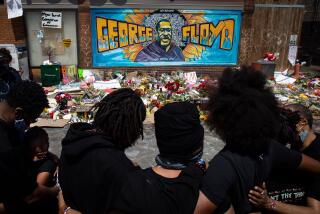Militants blame U.S. for their apparent beheading of U.S. journalist
- Share via
Reporting from New York — A video posted online Tuesday purported to show the beheading of an American journalist by the militant group Islamic State, nearly two years after the reporter disappeared in Syria.
The video, which was posted on YouTube and later taken down, shows a man who appears to be missing freelance journalist James Foley kneeling in the desert in an orange shirt and pants as a masked man in black stands beside him. The American recites a statement calling the U.S. government his “real killers” before he is beheaded.
The executioner then displays a second man, identified as another missing American journalist, Steven Joel Sotloff, and threatens to kill him if President Obama does not act, presumably to halt U.S. bombing of Islamic State fighters in Iraq.
“The life of this American citizen, Obama, depends on your next decision,” the masked man says in English, according to a transcript posted by SITE Intelligence Group.
It is not clear when or where the video was made, though the setting is a treeless expanse of desert.
Islamic State is an Al Qaeda offshoot, formerly known as ISIS, that has laid claim to a large swath of territory, first in Syria and then in Iraq, as part of its campaign to establish an Islamic caliphate in the heart of the Middle East.
After sweeping through the region, at times almost unchallenged, the group has recently suffered setbacks in Iraq, where the United States has provided air support to the Iraqi military and Kurdish militias fighting Islamic State. The U.S. airstrikes appear to have motivated the beheading displayed in the video.
In text in English and Arabic, the video accuses Obama of “placing America upon a slippery slope toward a new war front against Muslims.”
While kneeling in the desert, the man identified as Foley tells his parents not to take any compensation from the people who “effectively hit the last nail in my coffin from their recent aerial campaign in Iraq.”
A spokeswoman for the National Security Council, Caitlin Hayden, issued a statement saying that U.S. intelligence was working “as quickly as possible” to determine whether the video is authentic.
“If genuine, we are appalled by the brutal murder of an innocent American journalist and we express our deepest condolences to his family and friends,” she said.
The New York-based Committee to Protect Journalists issued a statement condemning the “barbaric murder of journalist James Foley.”
Foley’s mother, Diane Foley, also issued a statement, saying, “We have never been prouder of our son Jim. He gave his life trying to expose the world to the suffering of the Syrian people.
“We implore the kidnappers to spare the lives of the remaining hostages,” she continued. “Like Jim, they are innocents. They have no control over American government policy in Iraq, Syria or anywhere in the world.”
Foley went missing in 2012 while working as a freelance journalist for the Boston-based site GlobalPost. He had also spent 44 days in captivity in Libya while covering the conflict there.
Shortly after he disappeared in 2012, Foley’s family started a vocal campaign to find him and return him home safely. GlobalPost also hired ransom and kidnapping specialists who searched for Foley, according to Chief Executive Philip Balboni. Foley’s parents appeared on the “Today” show and on local television, and held vigils for him in Milwaukee, where he went to school, and in New Hampshire, where he grew up.
Although his family and GlobalPost deployed extensive resources to find Foley, they had been unable to confirm any information about his whereabouts. GlobalPost announced last year that it thought Foley was being held in a Syrian government detention center in Damascus alongside several other journalists. But Syria never confirmed that it had held him.
FindJamesFoley.org, a website dedicated to securing the release of the 40-year-old, acknowledged the video on its Twitter account, but said it had not been able to confirm its authenticity.
“We know that many of you are looking for confirmation or answers. Please be patient until we all have more,” the tweet read.
The 4-minute, 40-second video was produced by the Furqan Media Foundation, according to SITE Intelligence Group.
In November 2012, Foley was supposed to have met Nicole Tung, a freelance photojournalist, on Thanksgiving Day in Reyhanli, a town near the Turkish-Syrian border. When he was running several hours late, Tung suspected that something was wrong.
“I became concerned right away,” she said in an interview Tuesday. “I began calling everyone I could.”
She later learned through a Syrian contact that Foley had been abducted at gunpoint.
After Foley was released from captivity in Libya in 2011, he reflected on his experience in a video interview with the Boston Globe.
“I believe that frontline journalism is important,” he said. “Without these videos and photos and firsthand experience, you can’t really tell the world how bad it might be,” he said.
If the Foley video is authentic, it would not be the first time Islamic State targeted or killed journalists, both Syrian and foreign. This year, the Islamic State released several Spanish and French journalists, reportedly in exchange for large ransoms. At least 20 journalists are still missing in Syria, and 66 have been killed there because of their work.
The beheading video recalled the killing of Daniel Pearl, a Wall Street Journal reporter who was kidnapped in January 2002 in Pakistan and beheaded by his captors the next month. The video of his execution, in which Pearl spoke about his Jewish background, was also widely distributed.
Semuels reported from New York and Abdulrahim from Los Angeles. Times staff writer W.J. Hennigan in Washington contributed to this report.
Follow @AlanaSemuels and @RajaAbdulrahim on Twitter
More to Read
Sign up for Essential California
The most important California stories and recommendations in your inbox every morning.
You may occasionally receive promotional content from the Los Angeles Times.














